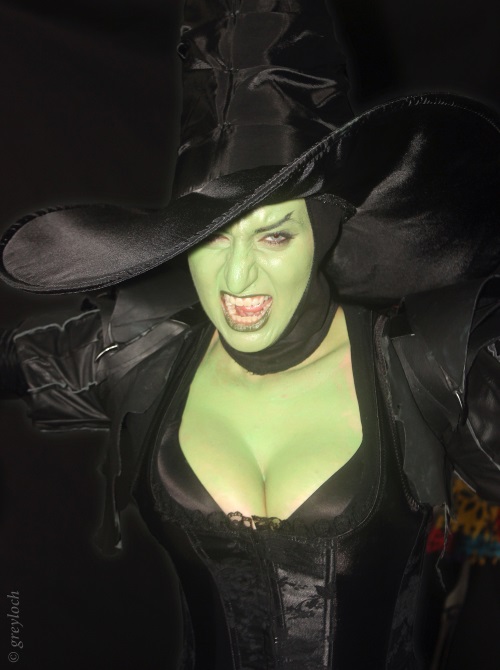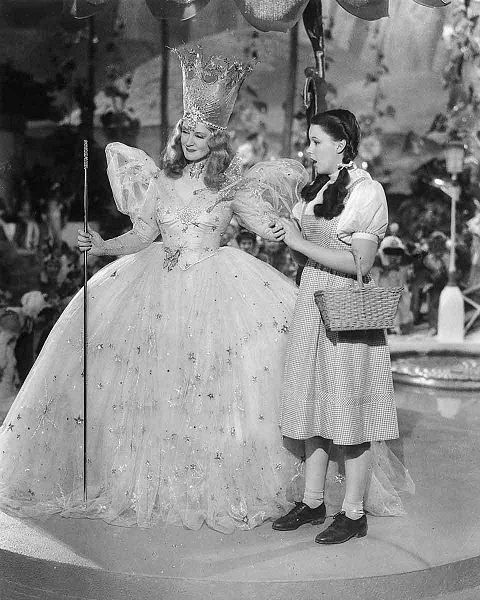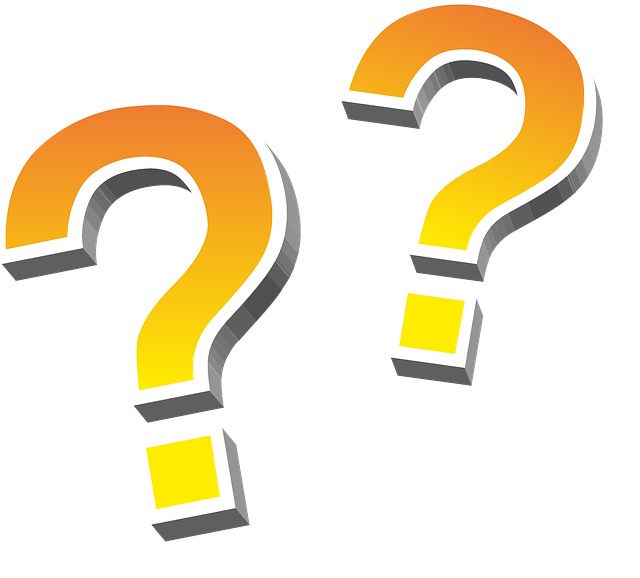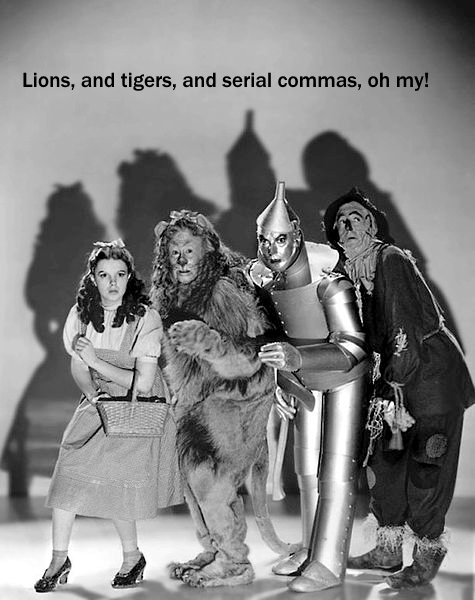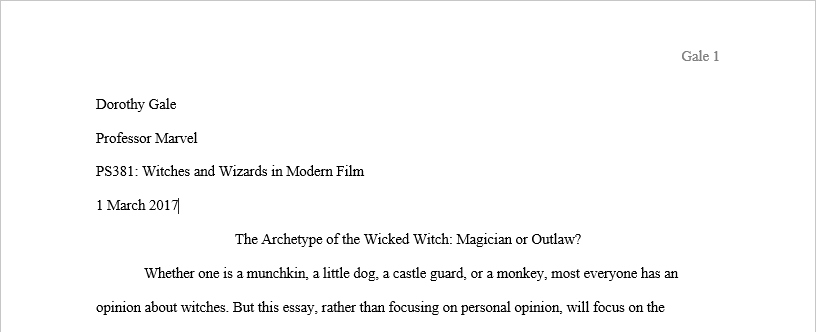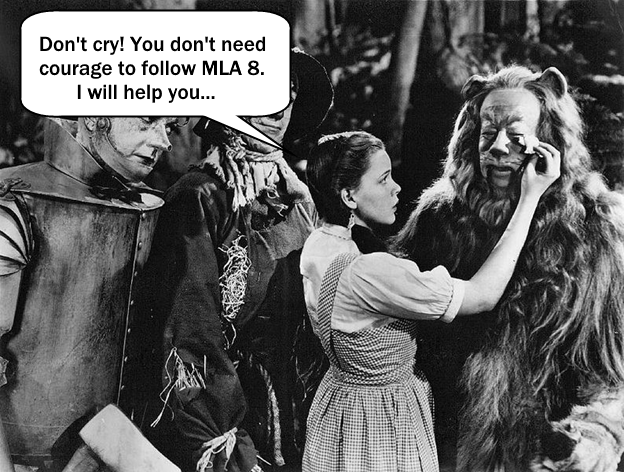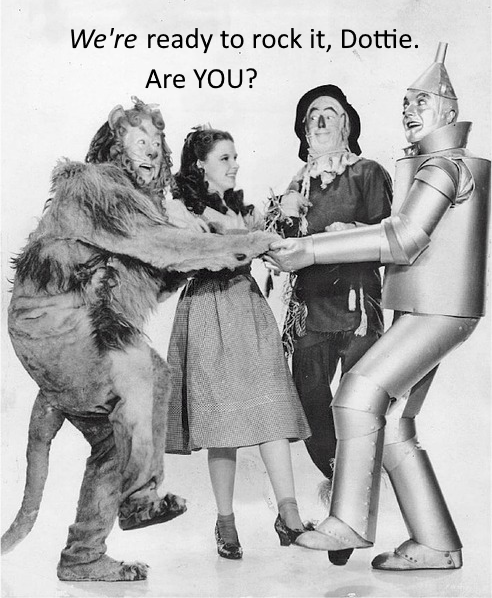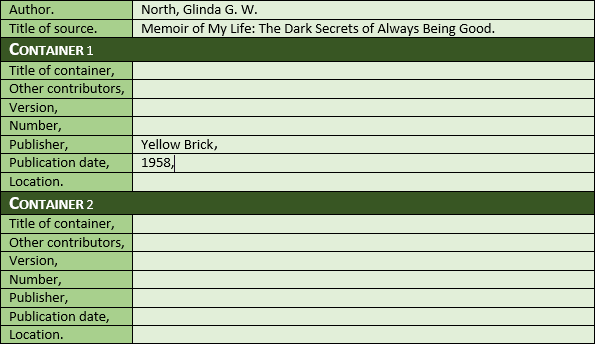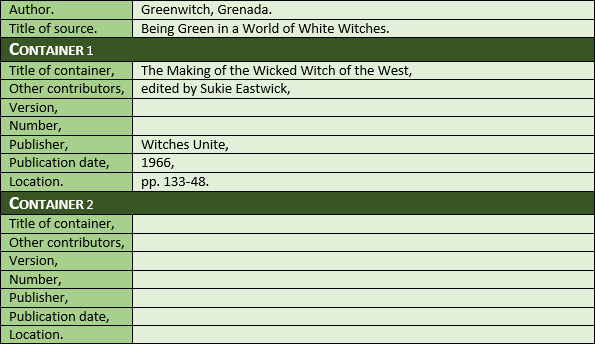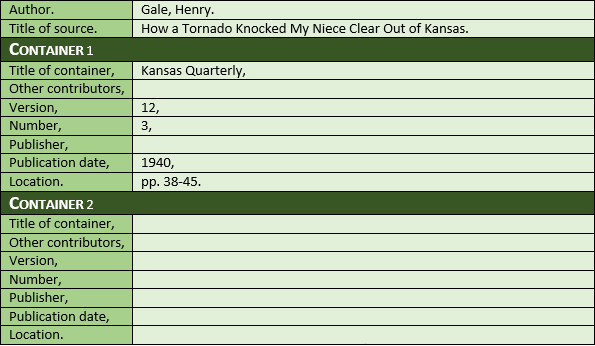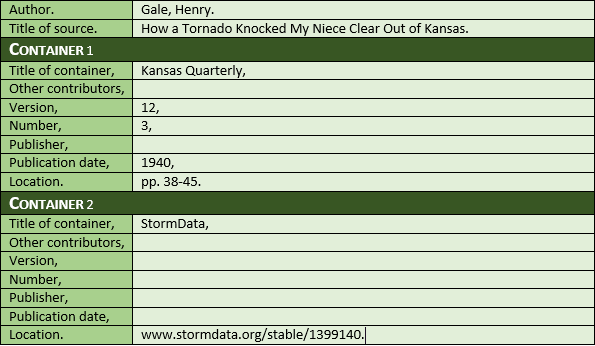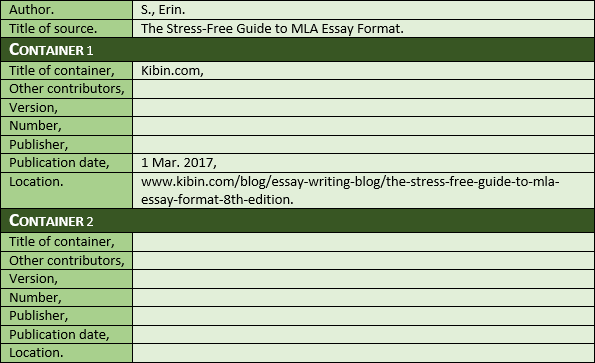“Ding dong, the witch is dead … the wicked witch is dead!”
The new 8th edition MLA Handbook (MLA 8) makes creating references on a Works Cited page so much easier than the 7th edition guidelines. You’ll be singing, too—once I walk you through it, that is!
The 7th edition MLA Handbook (MLA 7) was pretty darn complicated, listing a specific format for each conceivable type and variation of source material. It forced you to find the “right” format for each source. Or—if you’re anything like me—stressed you out as you tried to frantically cobble together several format elements to make it “work.”
MLA 7 didn’t accommodate new types of media very well either—how do you cite a Tweet? Or a reader comment at the bottom of an online news article? Or a YouTube video?
The good news is, MLA 8 makes the answers to all of those questions easy. In fact, it’s so digital-age-friendly that you can stop wishing for a magic wand to make your Works Cited page magically appear—or ruby slippers to click to make yourself disappear!
Using MLA 8 instead of MLA 7 is like becoming besties with the Good Witch Glinda instead of the Wicked Witch of the East. (Oof, sorry, MLA 7—should I be watching the skies for tornadoes and flying monkeys?)
So what’s the big change? It boils down to a shift in rules. MLA 7 was all about the rules. MLA 8 is more like a guiding set of principles, providing flexible guidelines that you can use for sources published in any type of media—including new, unpredictable media types.
This post is your stress-free guide to MLA essay format (8th edition). It covers everything you need to know, from formatting to referencing.
Ready? Kick off those ruby slippers, and let’s go.
MLA stands for Modern Language Association
Getting the Formatting Just Right for Your MLA Essay
From line spacing and the use of the serial comma to the title section, MLA is pretty specifc about how things should look in your MLA essay. Here’s a quick rundown of the basic elements.
Basic formatting
- Set all of your margins at one inch and your font type to Times New Roman, size 12.
- Set the whole document to be double-spaced (including the title section and Works Cited page) with no extra spaces between paragraphs.
- Indent the first line of each paragraph one half-inch, and use only one space between sentences.
Finally, use the serial comma. Love it or hate it, the serial comma is required in MLA. A serial comma (also known as the Oxford comma) is the final comma before the coordinating conjunction ( “and,” “or,” and “but”) in a list of three or more things.
Here’s a quick example. I included a serial comma before the “and”:
The Tin Man, the Scarecrow, the Cowardly Lion, and Dorothy followed the Yellow Brick Road.
The title section
In MLA format, you don’t need a whole title page. You just need a title section. In the upper left corner of your first page, type the following (keeping it double-spaced, of course!):
Your Name
Your Professor’s Name
The Class Title
The Date**
**The date format for MLA is day month year. So for example, if the current date is March 1, 2017, for MLA purposes, you would write this: 1 March 2017.
You also need an actual page header with your last name and page number, right justified. The page numbering should start on the first page and continue all the way through the very last page of your Works Cited.
Then, you also need to think up a snappy title. If you want to figure this out later, for now you can just type “Title.” (Don’t worry—I get it. Titles are hard, snappy or otherwise. But this post might help: How to Write Good Essay Titles That Are…Good).
Here’s how your paper should look so far:
For more formatting details, and examples of what the formatting looks like, check out the Purdue OWL’s General Format guide for papers and its MLA Sample Paper.
With me so far? See, no ruby slippers needed.
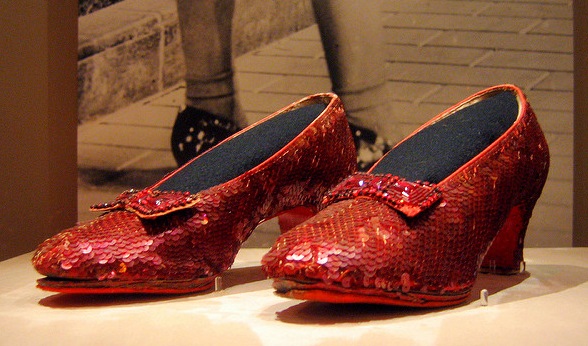
Creating In-Text Citations in MLA Essay Format
Any piece of information that came from your research—and not from your own brain, as mushy as it might be from all this MLA stuff—needs to be cited in order to identify the source of that information.
In other words, academic integrity is important. It means giving credit to authors when you use their ideas. This ensures you won’t get in trouble for plagiarism, not even the unintentional kind.
(See How to Avoid Plagiarism in Your Essay Writing for tips on appropriately citing information.)
All right, ready to start citing those sources? Click your heels together to say yes, but no disappearing on me.
Citing your sources is done using in-text citations. Beyond giving credit to the original author, in-text citations also align with the sources in your Works Cited (which we’ll get to in a bit!). This makes it easy for readers to find your original sources if they want to explore them.
In MLA, in-text citations include the author’s last name and the page number where the information appears in the source. In the example below, “Smith” is the author and “79” is the page number.
Research shows that flying monkeys really do hate little dogs (Smith 79).
Easy enough, eh?
If you include the author’s name in the text of a sentence, the page number still goes in parentheses at the end of the sentence. Here’s an example:
In My Love for the Wicked Witch, Smith was sincere when he said, “It tore me apart to see her melt” (17).
Also notice that the citation appears after the quotation marks and the period is placed after the citation—like so, “Quote in quotation marks” (Author #).
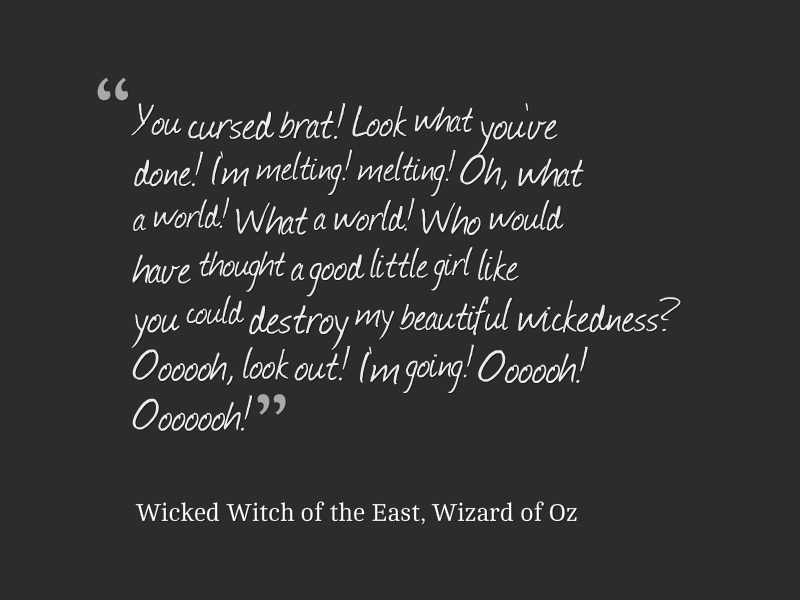
Have a source with no author? No problem. The title then serves in the same role as the author. Pretend the Smith source above didn’t have a listed author. The in-text citations for the above book source would look like this:
Research shows that flying monkeys really do hate little dogs (My Love for the Wicked Witch 79).
In My Love for the Wicked Witch, the author was sincere in saying, “It tore me apart to see her melt” (17).
 Tip: If a source has no author and you must use the title, use italics for longer works (e.g., books, plays, entire websites, TV shows,. movies). But use quotation marks for shorter works (e.g., book chapters, articles, a page on a website, episodes of a TV show).
Tip: If a source has no author and you must use the title, use italics for longer works (e.g., books, plays, entire websites, TV shows,. movies). But use quotation marks for shorter works (e.g., book chapters, articles, a page on a website, episodes of a TV show).
Have a source with two authors? Use this format:
“Quote in quotation marks” (Author and Author #).
Three or more authors? This one’s a little bit different. You only need the first listed author, followed by “et al.”—like so:
“Quote in quotation marks” (Author et al. #).
OR
According to Author et al., Dorothy’s ruby slippers were “all the rage” (#). (Because come on, who wouldn’t love red sparkly shoes?)
To see even more examples for various situations and source types, check out the Purdue OWL’s MLA In-Text Citation guide. It’s super-duper helpful and almost like having a magic wand!
Preparing your Works Cited Page in MLA Essay Format
Setting up your Works Cited page before you write your essay makes your life a whole lot easier. This allows you to fluidly add in-text citations and the corresponding reference entries in the Works Cited as you use each source in your essay. Sounds like a lot less hassle and confusion later, no?
 Bonus: When you finish your essay, the Works Cited page is already done too! All without a wand OR ruby slippers.
Bonus: When you finish your essay, the Works Cited page is already done too! All without a wand OR ruby slippers.
Clearly I’m biased on how you approach this, but you can also certainly make your Works Cited after your paper is complete if you wish.
Either way you do it, just make sure “Works Cited” begins at the top of the first blank page after the last paragraph of your essay. Also make sure it’s centered. In other words, after your final paragraph, go to the top of the next page. Then use “Works Cited” (no bold, no italics) at the top of it, centered. It should look like this:
It’s critical that readers can find the information you used—and that’s the purpose of your Works Cited page. It provides a map that leads directly to the exact sources of your information.
Phew! Now we’re ready to dive into the biggest changes in MLA 8. Ready? I promise to make it as painless as possible!
MLA 8 and the “Core Elements”
Remember those hair-pulling, pillow-throwing days of trying to figure out how to format a source that didn’t fit a predefined source type in MLA? Well, if you don’t, trust me, they weren’t fun! Either way, those days are officially over thanks to MLA 8.
The authors of MLA 8 were all about creating reliability and flexibility.
Instead of having different guidelines for different source types, in their wizard-like wisdom, the authors of MLA 8 provided a flexible set of core elements. That way, you can pick the most appropriate elements and skip elements that aren’t relevant.
So now, without further ado, I introduce to you the “core elements.” I’ve made a pretty little table to help you visualize how MLA lays this all out.
Here are the core elements:
Notice the punctuation after each element? This is the same punctuation you will use in your Works Cited entry after the corresponding piece of info.
Now, don’t get discouraged if you’re fuzzy on the details. Let’s break this down.
Sometimes sources are located within a larger source. To account for this, the table above has two containers, Container 1 and Container 2.
For example, a journal article within a database would require using both containers. In that situation, the journal information would go into Container 1, and the database info would go into Container 2.
For many sources, you might only need Container 1—the details of each source will help you determine that. But before we get too much into the weeds, let’s plant the seeds first, shall we?
Let’s look at each core element in order so that you know exactly how to use each one.
Author
The author is usually what it sounds like—it’s the name of the person (or persons) who created the work. However, this definition is flexible.
For example, if the focus is on the translation of a book, and not the content and ideas of the book itself, the translators’ names are used in the “author” position. If the focus is on the performance of a particular actor, rather than the TV episode itself, the actor’s name is used in the “author” position.
As in former MLA Handbook editions, if the author information is missing, the organization that created the work is listed as author.
And if all else fails and no author can be attributed, then that position is skipped. The entry begins with the title of the source instead.
In MLA format, the first and second authors listed for a source are written like this: Smith, John, and Tim Jones.
For three or more authors, you only need the first author, followed by “et al.” Like this, for example: Smith, John, et al.
For more variations, multiple works by the same author, etc., see the Purdue OWL’s Works Cited Page guide—and use the links on the left to find various situations. But remember, these are just examples. The core elements should be your guide to referencing your sources.
Title of source
The title of the source is the title of the work you’re most directly referencing. In other words, it’s the particular work within the container—such as an article within a periodical or an essay within an anthology.
But sometimes your source is self-contained, meaning it’s its own thing. In other words, it’s not a smaller part of a larger source. Books, websites (if citing the website as a whole), music albums, plays, a painting—these are all examples of self-contained works.
This means when you plug info into containers, Container 1 wouldn’t have a “Title of container.” Instead, you’d jump right to the next piece of info, “Other contributors.”
Important here is that ALL titles, regardless of their original formatting, are standardized. All titles are in title case with a colon used before any subtitle, even if the original title uses a dash or some other way to break up the main title and the subtitle. Titles should look like this:
This Is the Main Title: This Is the Subtitle
Title of container
The title of the container is simply the “whole” work that contains the subordinate work you’re specifically referencing. It may be an academic journal, a newspaper, a website, an album, or a regular radio episode series.
And more complicated situations follow the same pattern, or repeat the pattern. If past issues of a periodical are found in an online database, then the format would include Container 2, for example.
Other contributors
Other contributors refers to other people who contributed to the work, if that person’s contribution is important to the purpose of what you’re writing. You can start this section by describing the nature of the person’s contribution: Translated by, Edited by, etc.
Version, number, and publisher
- Version is pretty self-explanatory: if a source comes in various versions or editions, you indicate which one. For journal articles, for example, version is the volume number, which would require the abbreviation “vol.” before the number.
- Number is also self-explanatory: issue number, episode number, etc. The abbreviation “no.” is used in front of things like journal issue number or TV episode number.
- Publisher is fairly self-explanatory too. If the publisher is the same as the title of the container, omit the publisher name. For example, if you found an article on a website, the website itself might also be the publisher. Also note that, in MLA 8, the city of publication is no longer needed.
Publication date
The publication date should be written with the day first, the abbreviated month second, and the year third (Example: 17 Mar. 2017 instead of March 17, 2017).
If the source lists different dated information—such as a season or a span of months for a publication that covers several months—use that information instead. If not all of the information is provided, you include what is provided, even if it’s only the year.
One caveat here on websites. The copyright date or “last updated” date is NOT the same as a publication date. Many sites do not list a publication date. That’s okay. In such cases, you simply omit the publication date.
Location
The location of a work is dependent on the specific work. This could be the actual location of a painting, an album number, the page range for an article in a journal, or a web address. For any online sources, you must include the URL (but always omit the “http://.” This was optional in MLA 7, but mandatory in MLA 8. If the work has been assigned a doi, you should include that instead of the URL.
Key Points to Ensure You Rock Your MLA Essay Format
The key thing to remember is this: If your source has one of the core elements, list it in the Works Cited entry, and then go to the next element. If it doesn’t have a core element, skip it.
Let’s look at some examples—then you can safely toss those ruby red slippers to the back of your closet.
Before you dive into the examples (because I know you’re absolutely dying to, right?!), keep this in mind for ALL SOURCE TYPES. Yes, it’s really that important that I felt the need to put it in all bold caps. Ready?
For all titles (titles of sources or titles of Container 1 or Container 2), use italics for longer works and quotation marks for shorter works.
- Longer works: Books, plays, albums, anthologies, TV shows, journal titles, websites, magazines, newspapers, etc.
- Shorter works: Chapters, songs, articles in anthologies, TV show episodes, journal articles, title on the page of a website, magazine articles, newspaper articles, etc.
All right—now we’re ready. Deep breaths. Trust me, you totally got this!
Works Cited Examples for MLA Essay Format
Example #1: Book
Let’s say we’re citing a book called Memoir of My Life: The Dark Secrets of Always Being Good by Glinda G. W. North.
Here’s how the entry in your Works Cited would look if you’re just considering the placement and look of the core elements. (Note: The details in parentheses are simply to help define the element for you. They’re not part of the entry itself.)
Author. Title of Source (Book title in italics; books are self-contained). Other contributors, Version (edition), Number (volume #), Publisher, Publication date, Location (pages, URL, or doi). Container 2 title, Other contributors, Version (edition), Number, Publisher, Publication date, Location.
Remember, you only need to include the details that apply to the specific source. So you may not need all of the core elements.
Here’s what our table would like with the publication details plugged into the containers for book by Glinda North:
In your Works Cited, then, your entry for the book would look like this:
North, Glinda G. W. Memoir of My Life: The Dark Secrets of Always Being Good. Yellow Brick, 1958.
Example #2: Chapter in an anthology/book
What if you’re just citing a chapter or a book, or a work within an anthology? You’d use a very similar format to the book entry above, but more details would be included.
Here’s how the entry in your Works Cited would look if you’re just considering the placement and look of the core elements.
Author. “Title of Source” (Title of source in quotation marks, chapter name). Title of Container 1 (Title of book in italics). Other contributors, Version (edition), Number (volume #), Publisher, Publication date, Location (pages, URL, or doi). Container 2 title, Other contributors, Version (edition), Number, Publisher, Publication date, Location.
Again, you only need those elements that apply. In this instance, we have two added elements: 1) the title of Container 1 and 2) another contributor (an editor).
Here’s what our table would like with the publication details for an article in an anthology plugged into the containers:
In your Works Cited, then, your entry for the chapter would look like this:
Greenwitch, Grenada. “Being Green in a World of White Witches.” The Making of the Wicked Witch of the West, edited by Sukie Eastwick, Witches Unite, 1966, pp. 133-48.
Example #3: Journal article in print
For a journal article where you use a physical copy of the article from the actual physical journal (hey, sometimes everything isn’t available on the web!), here’s how the entry in your Works Cited would look if you’re just considering the placement and look of the core elements.
Author. “Title of Source” (Journal article title in quotation marks). Title of Container (Name of Journal in Italics), Version (vol. #), Number (issue no.), publication date, location (page range).
Here’s what our table would like with the publication details for a journal article in print plugged into the containers:
In your Works Cited, then, your entry for the journal article in print would look like this:
Gale, Henry. “How a Tornado Knocked My Niece Clear Out of Kansas.” Kansas Quarterly, vol. 12, no. 3, 1940, pp. 38-45.
Example #4: Journal article online
For a journal article published in a journal and then housed in a database, you’ll need both Container 1 and Container 2. Now, pretend the article used above is actually available online in the StormData database.
Here’s how the entry in your Works Cited would look if you’re just considering the placement and look of the core elements.
Author. “Title of Source” (Journal article title in quotation marks). Title of Container 1 (Name of journal in italics), Version (vol. #), Number (issue no.), publication date, location (page range, if article also appears in print). Title of Container 2 (database name), Location (URL or doi). Access date (optional, not included when doi or stable URL is used).
Here’s what our table would like with the publication details plugged into the containers:
In your Works Cited, then, your entry for the journal article in a database would look like this:
Gale, Henry. “How a Tornado Knocked My Niece Clear Out of Kansas.” Kansas Quarterly, vol. 12, no. 3, 1940, pp. 38-45. StormData, www.stormdata.org/stable/1399140.
Note: The above URL is a stable URL, so like a doi, it will never change. Thus, you would not need to provide an access date under any circumstances.
Example #5: Blog post
We’re about to get super meta here. For an example of a newer media format, here’s how you would cite this very blog. For any blog post, you’ll likely only need Container 1.
Here’s how the entry in your Works Cited would look if you’re just considering the placement and look of the core elements that are relevant here.
Author. “Title of Source” (Blog post title in quotation marks). Title of Container 1 (Website name in italics). URL. Date of access.
Here’s how our table would look with the publication details plugged into the containers:
In your Works Cited, then, your entry for the chapter would look like this:
S., Erin. “The Stress-Free Guide to MLA Essay Format.” Kibin.com, 1 Mar. 2017, www.kibin.com/blog/essay-writing-blog/the-stress-free-guide-to-mla-essay-format-8th-edition. Accessed 1 Mar. 2017.
A few important notes here:
- Kibin is also the publisher. But since the publisher name and the title of Container 1 (Kibin.com) are essentially the same thing, the publisher is not listed separately.
- I’ve included the date of access (Accessed 1 Mar. 2017), but this is NOT a mandatory element in MLA. You only need to include access dates if your instructor requires you to do so. The date of access and the published date are the same as well for this particular source, but this would be rare in real life. See, very meta!
If you need more help with using the core elements, Purdue OWL provides the definitions and examples for each element in its guide for creating a Works Cited list.
Now Do It!
Now that you know what everything means, you can start documenting your sources.
Here’s a few final things to remember:
- Arrange the entries in alphabetical order based on the first word of each entry (ignoring articles—i.e., “a,” “an,” and “the”).
- Left align the first line of each entry, and use a hanging ½ inch indent for all subsequent lines of the same source.
- Use title case for all titles, which means prepositions and articles are not capitalized unless they are the first/last word of the title or the first word after a colon.
Here’s how your Works Cited page should look:
To make your own Works Cited entries easier and stress-free, use the pretty little table shown in the examples above to fill in source details for your own MLA essay. You can grab some blank copies of it here to fill in the core elements until you’re ready to put your Works Cited together.
EasyBib also makes referencing your sources easy and has links for each of the core elements. That’s about as close to a magic wand as you’ll get!
For more details on the changes in MLA 8, read it straight from the witch’s mouth on the Modern Language Association’s Webpage.
Once you’ve wrapped up your paper and your Works Cited page, you can always have a second set of eyes looks things over by sending your paper to a Kibin editor—your own magical secret weapon for catching any MLA 8 errors!
Now fly like monkeys and cite! Cite, my pretties, cite!
